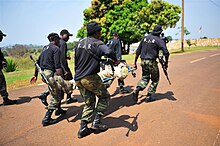The Rapid Intervention Battalion (Bataillon d'Intervention Rapide, or BIR) is an elite military force and an army combat unit of the Cameroonian Armed Forces.
The unit is supported by the United States, reports directly to the president of Cameroon, and has played a large part in the Cameroonian and regional war against Boko Haram. The unit has also been accused of torturing and killing detainees at a number of its bases in northern Cameroon and in Nigeria.
Structure and activities

The BIR was created in 2001 in Cameroon's struggle against armed groups and gangs on its borders.

The BIR is better equipped, trained and paid than ordinary units in Cameroon's army. The unit is led by a retired Israeli officer and reports directly to Cameroon's president, instead of to the ministry of defense. The BIR has worked closely with the US military since 2007 or earlier.
A part of the BIR's objectives includes controlling the illegal circulation of arms. The BIR has also been cited by poachers and ivory traders as a threat to illegal trade in animal goods.
In 2016, the BIR participated in the US- and AFRICOM- sponsored Exercise Obangame and Saharan Express wargames, meant to increase regional military cooperation between central African nations and the United States. The BIR hosted a significant portion of the exercises, involving 32 nations including the UK, France and Germany, at its base in Idenau.
Operation Alpha
The BIR has launched Operation Alpha, a counterterrorism campaign against Boko Haram that has received international support. The operation's efforts have been central to the war waged by Cameroon, Nigeria, Niger and Chad against Boko Haram.
The operation's headquarters are in Salak. According to Amnesty International, Salak is also used as an illegal prison to house persons detained by the BIR.
The BIR also conducts operations from the border town of Fotokol in Nigeria, where it converted a closed school into a military base. In 2016, approximately 1000 BIR soldiers were reported to have captured the town of Kumshe, Nigeria from Boko Haram.
Foreign support

The BIR has received equipment and training from the United States and Israel. In the spring of 2016, US Ambassador to Cameroon Michael Hoza praised the unit, stating, "In their training, conduct, and leadership, the BIR exhibited all of the values we expect in our own armed forces — professionalism, protection of the civilian population, and respect for human rights." The US military has confirmed that works with the BIR in the fight against Boko Haram, and has stated that approximately 300 US military personnel are working with the BIR at any given time.
Michael Page, a former US state department and intelligence analyst, has described the BIR as a Cameroonian "army within-an-army" for the United States.
Accusations of human rights abuses
Amnesty International has accused the BIR of torturing detainees, supporting these accusations with leaked videos of soldiers wearing BIR uniforms and torturing detainees. The organization has stated that the detainees are primarily men of military age, Muslim, and of Kanuri ethnicity, but that women and children have also been held. Both men and women have been tortured. Tortured detainees have testified that American soldiers were present at BIR bases where they were detained. Every year since 2010, the US State Department has issued a report accusing the BIR of human rights abuses including killings and assaults.
In 2017, the U.S. Army began an inquiry into the torture allegations at the request of General Thomas Waldhauser, the commander of AFRICOM.
Footage analyzed by BBC Africa Eye has shown BIR soldiers burning a house down in the Azi village of Southwest Region. Cameroon's Communication Minister Issa Tchiroma Bakary denied that the men were actually BIR soldiers, instead claiming that they were separatists in captured uniforms. An OSINT investigation by individuals associated with bellingcat, and Amnesty International, linked the BIR to the execution of women and children, believed to be in Mayo-Tsanaga.
See also
References
- ^ Browne, Ryan (7 August 2017). "US military launches inquiry into torture allegations at Cameroon base". CNN. Retrieved 14 January 2018.
- ^ Trafford, Robert; Turse, Nick (20 July 2017). "Cameroonian Troops Tortured and Killed Prisoners at Base used for US Drone Surveillance". The Intercept. Retrieved 14 January 2018.
- Amin, Julius (2014). African Immersion: American College Students in Cameroon. Lexington Books. ISBN 9781498502382. Retrieved 14 January 2018.
- ^ Page, Matthew (26 July 2017). "In the war on Boko Haram, is the U.S. turning a blind eye to Cameroon's abuses?". The Washington Post. Retrieved 14 January 2018.
- ^ Randolph, Shannon; Stiles, Daniel (2011). Elephant meat trade in Central Africa : Cameroon case study. IUCN.
- ^ "Obangame/Saharan Express 2016 concludes". DefenceWeb. 30 March 2016.
- ^ "Cameroon's Secret Torture Chambers". The Guardian. Forensic Architecture and Amnesty International. Retrieved 14 January 2018.
- "Au Nigeria, Kumché libérée de l'emprise de Boko Haram". RFI. 24 February 2016. Retrieved 14 January 2018.
- ^ "Burning Cameroon: Images you're not meant to see". BBC News. June 25, 2018. Archived from the original on June 26, 2018.
- ^ Maclean, Ruth (19 July 2017). "Cameroon 'torturing people accused of supporting Boko Haram'". The Guardian. Retrieved 14 January 2018.
- Maclean, Ruth (July 13, 2018). "Video shows Cameroon army killing women and children, says Amnesty". The Guardian.
- "Cameroon military extrajudicial execution of women and children. Most horrendous act to watch". YouTube. July 10, 2018. Retrieved July 13, 2018.
An investigation by Amnesty International experts has gathered credible evidence that it was Cameroonian soldiers depicted in a video carrying out the horrific extrajudicial executions of two women and two young children.
- Strick, Benjamin (July 13, 2018). "Possible site of #Cameroon execution video? It's a work in progress with @danriversitv & @bellingcat resources. The possible location is 10.92666667, 14.16722222 as suggested by @danriversitv - I've just added a few more notes on the path. Again, this is a work in progress" (Tweet). Archived from the original on July 13, 2018 – via Twitter.